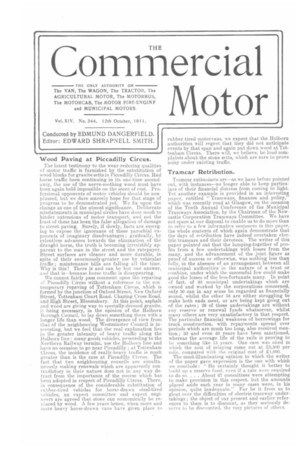Wood Paving at Piccadilly Circus.
Page 1

If you've noticed an error in this article please click here to report it so we can fix it.
The latest testimony to the wear-reducing qualities of motor traffic is furnished by the substitution of wood blocks for granite setts in Piccadilly Circus. Had horse traffic been continuing in its one-time ascendancy, the use of the nerve-soothing wood must have been again held impossible on the score of cost. Professional opponents of motor vehicles should be non plumed, but we dare scarcely hope for that stage of progress to be demonstrated yet. We fix upon the change as one of the utmost significance. Deliberate misstatements in municipal circles have dime much to hinder extensions of motor transport, and not the least of these has been the false allegation of damage to street.paving. Surely, if slowly, facts are emerging to expose the ignorance of these parochial exponents of imaginary disadvantages ; gra'dually, by relentless advances towards the elimination of the draught horse, the truth is becoming irresistibly apparent to the man in the street and the ratepayer. Street surfaces are cleaner and more durable, in spite of their enormously-greater use by vehicular traffic ; maintenance bills are falling all the time. Why is this? There is and can be but one answer, and that is—because horse traffic is disappearing. We cannot fairly pass comment upon the repaving of Piccadilly Circus without a reference to the con temporary repaving of Tottenham Circus, which is formed by the junction of Oxford Street, New Oxford Street Tottenham Court Road, Charing Cross Road, and High Street, Bloomsbury. At this point, asphalt and wood are giving way to specially-dressed granite, it being necessary, in the opinion of the Holborn Borough Council, to lay down something there with a longer life than wood. The divergence of view from that of the neighbouring Westminster Council is interesting, but we feel that the real explanation lies in the greater intensity of heavy traffic along the Holborn line : many goods vehicles, proceeding to the Northern Railway termini, use the Holborn line and have no occasion to go near Piccadilly ; at Tottenham Circus, the incidence of really-heavy traffic is much greater than is the case at Piccadilly Circus. The fact that two neighbouring councils are simultaneously making renewals which are apparently contradictory in their nature does not in any way detract from the importance of the course which has been adopted in respect of Piccadilly Circus. There, in consequence of the considerable substitution of rubber-tired vehicles for horse-drawn steel-tired vehicles, an expert. committee and expert engineers are agreed that stone can economically be rep:aced by wood. A few years hence, when more and more heavy horse-drawn vans have given place to
J rubber-tired motorvans, we expect that the Holborn
authorities will regret that they did not anticipate
events by that span and again put down wood at Tottenham Circus. There will, we believe, be loud complaints about the stone setts, which are sure to prove noisy under existing traffic.
Tramcar Retribution.
Tramcar enthusiasts are—as we have before pointed out, with instances—no longer able to keep particulars of their financial distress from coming to light. Yet another example is provided in an interesting paper, entitled " Tramways, finances and policy," which was recently read at Glasgow, on the occasion of the Tenth Annual Conference of the Municipal Tramways Association, by the Chairman of the Newcastle Corporation Tramways Committee. We have not space at our disposal to enable us to do more than to refer to a few informative sentences in this paper, the whole contents of which again demonstrate that the days of retribution have indeed overtaken electric tramcars and their devotees. The writer of this paper pointed out that the lumping-together of profits from a few undertakings with losses from the many, and the advancement of the joint figure as proof of success or otherwise, was nothing less than folly, in the absence of an arrangement between all municipal authorities in the nature of a trust or combine, under which the successful few could make good the losses of the less-fortunate many. In point of fact, of 88 municipal undertakings which are owned and worked by the corporations concerned, only 30 can in any sense be regarded as financially sound, whilst the other 58 are either struggling to make both ends meet, or are being kept going out of the rates ; 26 of these undertakings are without soy reserve or renewal funds whatsoever, whilst many others are very unsatisfactory in that respect. The particular financial weakness of borrowings for track construction, with repayments spread over periods which are much too long, also received mention; 30 and even 40 years have been sanctioned, whereas the average life of the rails is proving to he something like 15 years. One case was cited in which the cost of relaying came out at £5,500 per mile, compared with the original cost of £1,000.
The most-illuminating opinion to which the writer of the paper gave expression is the one with which we conclude : " He certainly thought it better to build up a reserve fund, even if a rate were required to do so. . . About 67 committees were attempting to make provision in this respect, but the amounts placed aside each year in many cases were, in his opinion, quite inadequate." Far be it from us to gloat over the difficulties of electric-tramway undertakings; the object of our present and earlier references to them is to discount, as they seriously deserve to be discounted, the rosy pictures of others.
























